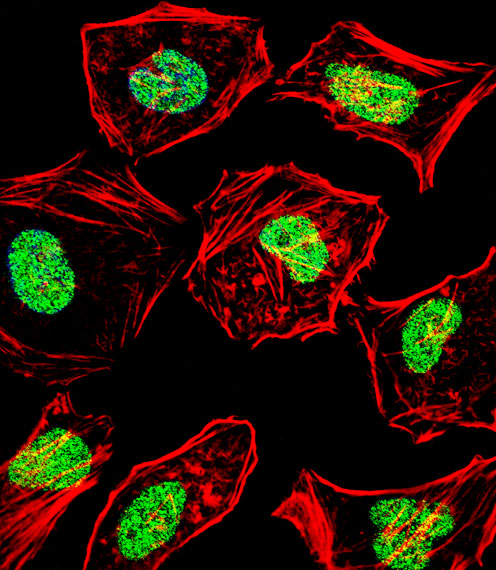HAND2 Antibody (Center)
Affinity Purified Rabbit Polyclonal Antibody (Pab)
- SPECIFICATION
- CITATIONS: 1
- PROTOCOLS
- BACKGROUND

Application
| IF, WB, E |
|---|---|
| Primary Accession | P61296 |
| Other Accession | P57101, P61295, Q61039, Q90690, NP_068808.1 |
| Reactivity | Human |
| Predicted | Chicken, Mouse, Rat, Xenopus |
| Host | Rabbit |
| Clonality | Polyclonal |
| Isotype | Rabbit IgG |
| Calculated MW | 23666 Da |
| Antigen Region | 81-110 aa |
| Gene ID | 9464 |
|---|---|
| Other Names | Heart- and neural crest derivatives-expressed protein 2, Class A basic helix-loop-helix protein 26, bHLHa26, Deciduum, heart, autonomic nervous system and neural crest derivatives-expressed protein 2, dHAND, HAND2, BHLHA26, DHAND |
| Target/Specificity | This HAND2 antibody is generated from rabbits immunized with a KLH conjugated synthetic peptide between 81-110 amino acids from the Central region of human HAND2. |
| Dilution | IF~~1:10~50 WB~~1:1000 E~~Use at an assay dependent concentration. |
| Format | Purified polyclonal antibody supplied in PBS with 0.09% (W/V) sodium azide. This antibody is purified through a protein A column, followed by peptide affinity purification. |
| Storage | Maintain refrigerated at 2-8°C for up to 2 weeks. For long term storage store at -20°C in small aliquots to prevent freeze-thaw cycles. |
| Precautions | HAND2 Antibody (Center) is for research use only and not for use in diagnostic or therapeutic procedures. |
| Name | HAND2 |
|---|---|
| Synonyms | BHLHA26, DHAND |
| Function | Essential for cardiac morphogenesis, particularly for the formation of the right ventricle and of the aortic arch arteries. Required for vascular development and regulation of angiogenesis, possibly through a VEGF signaling pathway. Also plays an important role in limb development, particularly in the establishment of anterior- posterior polarization, acting as an upstream regulator of sonic hedgehog (SHH) induction in the limb bud. Is involved in the development of branchial arches, which give rise to unique structures in the head and neck. Binds DNA on E-box consensus sequence 5'-CANNTG- 3' (By similarity). |
| Cellular Location | Nucleus {ECO:0000255|PROSITE-ProRule:PRU00981}. |
| Tissue Location | Heart. |

Provided below are standard protocols that you may find useful for product applications.
Background
The protein encoded by this gene belongs to the basic helix-loop-helix family of transcription factors. This gene product is one of two closely related family members, the HAND proteins, which are asymmetrically expressed in the developing ventricular chambers and play an essential role in cardiac morphogenesis. Working in a complementary fashion, they function in the formation of the right ventricle and aortic arch arteries, implicating them as mediators of congenital heart disease. In addition, this transcription factor plays an important role in limb and branchial arch development.
References
Shen, L., et al. Chin. Med. J. 123(13):1623-1627(2010)
Jugessur, A., et al. PLoS ONE 5 (7), E11493 (2010) :
Voth, H., et al. BMC Mol. Biol. 10, 28 (2009) :
Morikawa, Y., et al. Circ. Res. 103(12):1422-1429(2008)
Han, Z., et al. Development 133(6):1175-1182(2006)
If you have used an Abcepta product and would like to share how it has performed, please click on the "Submit Review" button and provide the requested information. Our staff will examine and post your review and contact you if needed.
If you have any additional inquiries please email technical services at tech@abcepta.com.














 Foundational characteristics of cancer include proliferation, angiogenesis, migration, evasion of apoptosis, and cellular immortality. Find key markers for these cellular processes and antibodies to detect them.
Foundational characteristics of cancer include proliferation, angiogenesis, migration, evasion of apoptosis, and cellular immortality. Find key markers for these cellular processes and antibodies to detect them. The SUMOplot™ Analysis Program predicts and scores sumoylation sites in your protein. SUMOylation is a post-translational modification involved in various cellular processes, such as nuclear-cytosolic transport, transcriptional regulation, apoptosis, protein stability, response to stress, and progression through the cell cycle.
The SUMOplot™ Analysis Program predicts and scores sumoylation sites in your protein. SUMOylation is a post-translational modification involved in various cellular processes, such as nuclear-cytosolic transport, transcriptional regulation, apoptosis, protein stability, response to stress, and progression through the cell cycle. The Autophagy Receptor Motif Plotter predicts and scores autophagy receptor binding sites in your protein. Identifying proteins connected to this pathway is critical to understanding the role of autophagy in physiological as well as pathological processes such as development, differentiation, neurodegenerative diseases, stress, infection, and cancer.
The Autophagy Receptor Motif Plotter predicts and scores autophagy receptor binding sites in your protein. Identifying proteins connected to this pathway is critical to understanding the role of autophagy in physiological as well as pathological processes such as development, differentiation, neurodegenerative diseases, stress, infection, and cancer.


